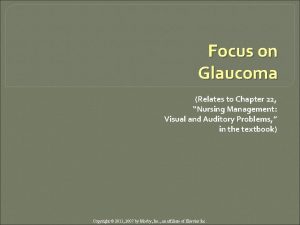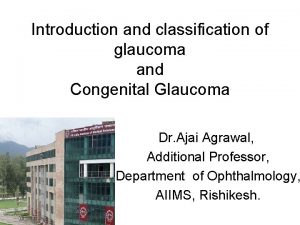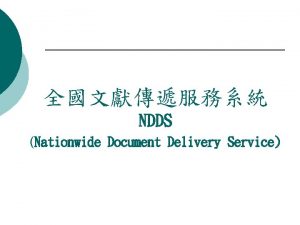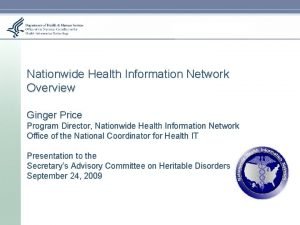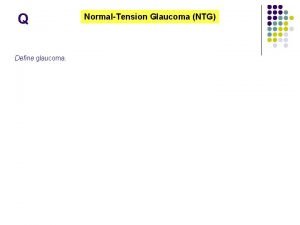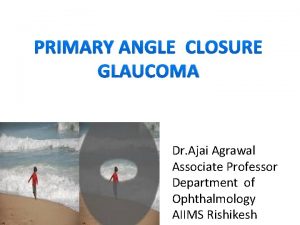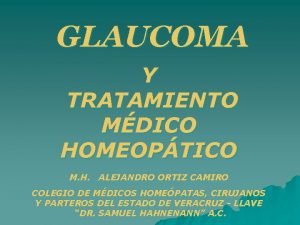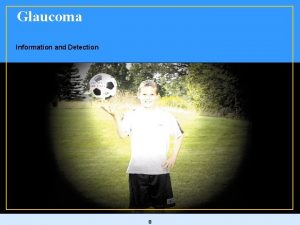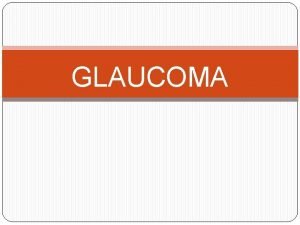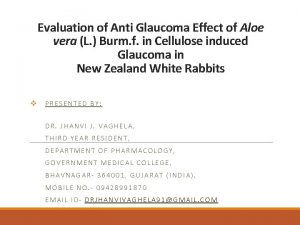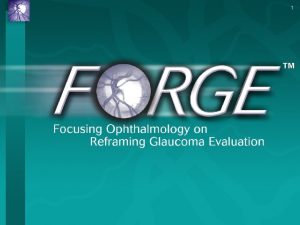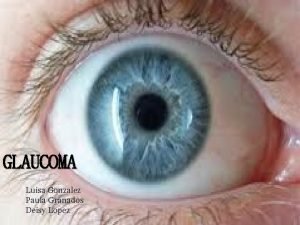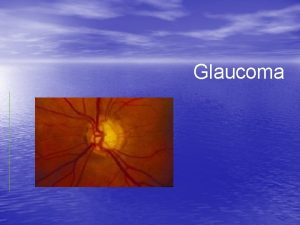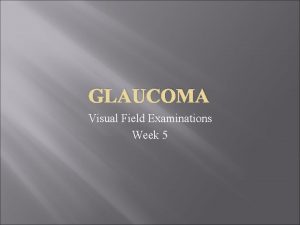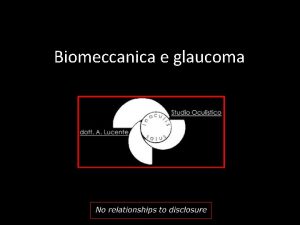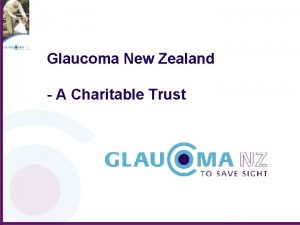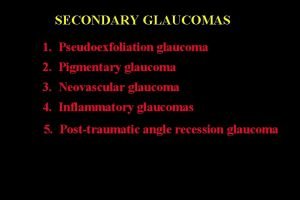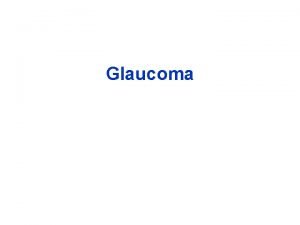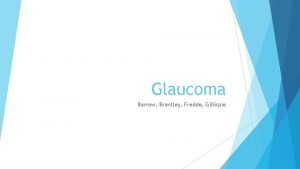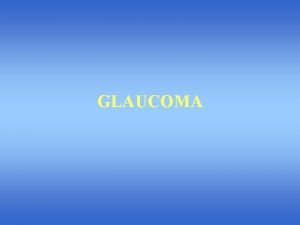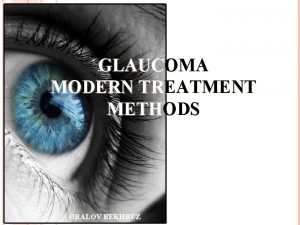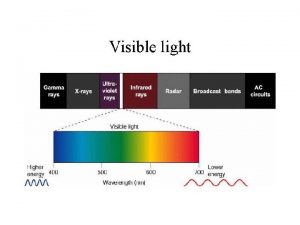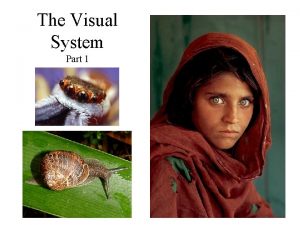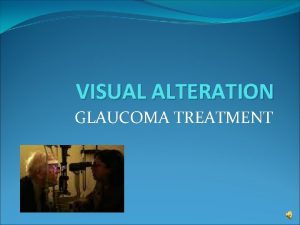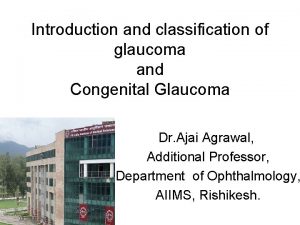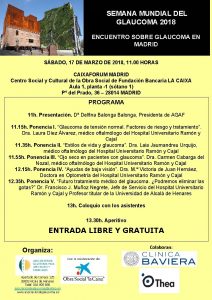Glaucoma management in Canada results from a nationwide

























- Slides: 25

Glaucoma management in Canada – results from a nationwide survey. Caputo MV 1, Arshinoff S 2, 3, Scott G 4, Mitchell B 1 1 Northern Ontario School of Medicine; 2 University of Toronto; 3 Mc. Master University; 4 Laurentian University


Overview Background: glaucoma is a leading cause of vision loss & disability in Canada. Problem: sharp rise in vision loss expected through 2030. Gap: little data available regarding glaucoma care practices in Canada. Contribution: first study attempting to define current state of glaucoma care in Canada.

Context https: //www. aao. org/eye-health/diseases/glaucoma-vision-simulator

Context Visual impairment exacts major social and economic costs 1 1 http: //www. cnib. ca/en/about/media/vision-loss/Pages/default. aspx

Context Vision loss costs Canadians more health care dollars annually than any other disease category 2 2 The Cost of Vision Loss in Canada: A Report by Access Economics Pty Limited for CNIB and COS, June 2009; available at www. cnib. ca.

Context The prevalence of vision loss in Canada is expected to increase nearly 30% in the next decade 1 -3

Problem Glaucoma: optic neuropathy +/- vision loss 3 • Second-leading cause of irreversible blindness in Canada 1 -3 • Associated with diagnostic delay 1 -3 • Timely treatment minimizes blindness 3 • Current standard of care relies on specialist involvement and availability of costly equipment 3 • Substantial variability in access to timely, quality health care in northern, rural, underserved regions 3 http: //cos-sco. ca/wp-content/uploads/2012/09/Vision. Lossin. Canada_e. pdf

Study Objective The aim of this study was to identify the current state of glaucoma management in Canada.

Survey Design Questions included: • Cross-sectional, self-report survey design • Survey endorsed by Canadian Ophthalmological Society • Does your department/practice have a designated person with over-riding responsibility for glaucoma care? • Total number of patient visits to physicians and/or nurses during week 42? • Number of visits related to glaucoma during the same week? • Total number of patient visits (all-cause) to physicians or physicians and nurses? • • • # visits to nurse without a physician appointment? # visual field tests (# eyes tested)? Creswell, J. W. (2013). Research design: Qualitative, quantitative, and mixed methods approaches. Sage publications. # eyes subjected to fundus photography and/or computerized imaging? • Available diagnostic equipment (answers given by checking a table).

Electronic Survey

Data Collection • A modified Dillman approach was used: Initial survey 2 weeks 2 nd copy of survey 3 weeks First reminder 3 weeks Final reminder Hoddinott, Susan N. , and Martin J. Bass. "The Dillman total design survey method. " Canadian family physician 32 (1986): 2366.

Data Analysis • Descriptive statistics • Kruskal-Wallis Test

Results • Survey sent to 624 ophthalmologists practicing in Canada. • 109 completed responses were received: § 104 English (95. 4%) § 5 French (4. 6%) • Response rate: =109/624 =0. 17468 = 17. 5%

Participant Demographics Survey Item Title Ophthalmologist Resident/trainee Province British Columbia Alberta Saskatchewan Manitoba Ontario Quebec Nova Scotia New Brunswick Prince Edward Island Newfoundland Labrador Community Population <10, 000 – 49, 999 50, 000 – 99, 999 100, 000+ Participants (n, %) 103 (94. 5) 6 (5. 5) 22 (20. 2) 9 (8. 3) 2 (1. 8) 3 (2. 8) 45 (41. 3) 16 (14. 7) 7 (6. 4) 4 (3. 7) 1 (0. 9) 0 (0) 1 (0. 9) 12 (11. 0) 7 (6. 4) 89 (81. 7)

Results Total number of patient visits per week Mean = 296 (range = 20 – 3200) Total number of glaucoma-related visits per week Mean = 95 (range = 10 – 1100) Total number of glaucoma-related visits to a nonphysician per week* Mean = 24 (range = 0 – 440) British Columbia Alberta Saskatchewan Manitoba Ontario Quebec Nova Scotia New Brunswick Prince Edward Island Md = 20/week Md = 2/week Md = 8/week Md = 1/week Md = 0/week Md = 10/week Md = 12. 5/week Md = 4/week * p <0. 05

Results Does your practice utilize Tele. Ophthalmology services? Yes (6. 4%) ‘Please choose one of the following as the statement that best describes the reason your practice does not use Tele. Ophthalmology services’: • • No (93. 6%) Tele. Ophthalmology would not benefit my patients (12. 7%) I have been meaning to look further into using Tele. Ophthalmology services (17. 6%) Tele. Ophthalmology could lead to worse patient outcomes (0%) Tele. Ophthalmology does not make financial sense to my practice (2. 9%) Tele. Ophthalmology? Never heard of it (2. 9%) Tele. Ophthalmology takes too long and limits the number of patients I can see (6. 9%) Equipment setup is complicated and time consuming (7. 8%)

Results Do you feel that you have access to the equipment you need to properly identify and manage patients with glaucoma? 100 90 80 70 60 50 40 30 20 10 0 Yes No

Discussion • Patient volumes and Teleophthalmology usage varies greatly across the province. • Glaucoma management by interdisciplinary teams, including visits to nonphysicians, would appear to be an underutilized area across the majority of provinces. • Despite a wide range of reported estimates of patient visits and glaucoma specific visits, there was not a statistically significant difference in the volume of patients seen per week based on province or LHIN in Ontario. • Teleophthalmology would appear to be highly underutilized. • The majority of physicians felt that they had access to the equipment needed to properly identify and manage patients with glaucoma.

Future Directions • Greater understanding of the distribution of eye care services provided in Canada would be valuable. • There may exist a wealth of information based on the non-respondents to this study. • Methods of delivering care cost- effectively to remote populations and new methods of delivering eye care more effectively in urban and rural Canada should be explored. – CNIB Eye Van – Tele. Ophthalmology (diabetic retinopathy, glaucoma, ARMD)

Limitations • Significant risk of non-response bias due to limited response rate • Volunteer bias • Technical challenges

Conclusions • This study serves as a baseline measure of glaucoma management in Canada. • Unequal distribution of practitioners and resources. • Unclear of the impact on patient care/outcomes. • Health service delivery models specific to rural ophthalmology care should be explored.

References 1. 2. 3. 4. 5. 6. Chauhan, B. C. , Mikelberg, F. S. , Balaszi, A. G. , Le. Blanc, R. P. , Lesk, M. R. , & Trope, G. E. (2008). Canadian Glaucoma Study: 2. risk factors for the progression of open-angle glaucoma. Archives of ophthalmology, 126(8), 10301036. Fung, S. S. , Lemer, C. , Russell, R. A. , Malik, R. , & Crabb, D. P. (2013). Are practical recommendations practiced? A national multi-centre cross-sectional study on frequency of visual field testing in glaucoma. British Journal of Ophthalmology, bjophthalmol-2012. Iskedjian, M. , Walker, J. , Vicente, C. , Trope, G. E. , Buys, Y. , Einarson, T. R. , & Covert, D. (2003). Cost of glaucoma in Canada: analyses based on visual field and physician's assessment. Journal of glaucoma, 12(6), 456 -462. Leske, M. C. , Heijl, A. , Hyman, L. , Bengtsson, B. , & Early Manifest Glaucoma Trial Group. (1999). Early Manifest Glaucoma Trial: design and baseline data. Ophthalmology, 106(11), 2144 -2153. Linden, C. , Bengtsson, B. , Alm, A. , Calissendorff, B. , Eckerlund, I. , & Heijl, A. (2013). Glaucoma management in Sweden—results from a nationwide survey. Acta Ophthalmology, 91(1), 20 -24. Verma, S. , Arora, S. , Kassam, F. , Edwards, M. C. , & Damji, K. F. (2014). Northern Alberta remote teleglaucoma program: clinical outcomes and patient disposition. Canadian Journal of Ophthalmology, 49(2), 135 -140.

Acknowledgements • Dr. Brian Mitchell & Dr. Steve Arshinoff • Sault Ste. Marie Academic Medical Association • NOSM Dean’s Summer Student Research Award

Questions?
 Cataracts nursing interventions
Cataracts nursing interventions Nursing assessment of glaucoma
Nursing assessment of glaucoma Stumped cloudy cornea
Stumped cloudy cornea Nationwide yourlife carematters
Nationwide yourlife carematters Nationwide yourlife indexed ul accumulator
Nationwide yourlife indexed ul accumulator Nationwide mission statement
Nationwide mission statement Is 211 nationwide
Is 211 nationwide Ebsco password
Ebsco password Nationwide social security 360 analyzer
Nationwide social security 360 analyzer Nationwide health information network
Nationwide health information network Nationwide indexed universal life accumulator ii
Nationwide indexed universal life accumulator ii Medicare nationwide
Medicare nationwide Nationwide data collection
Nationwide data collection Uvea
Uvea Triggerfish glaucoma
Triggerfish glaucoma Glaucoma
Glaucoma Treatment for open angle glaucoma
Treatment for open angle glaucoma Primary angle closure glaucoma
Primary angle closure glaucoma Drenaje humor acuoso
Drenaje humor acuoso Open angle glaucoma risk factors
Open angle glaucoma risk factors Open angle glaucoma symptoms
Open angle glaucoma symptoms Bayoneting vessels glaucoma
Bayoneting vessels glaucoma Notch glaucoma
Notch glaucoma Is aloe vera good for glaucoma
Is aloe vera good for glaucoma Isnt rule
Isnt rule Anillo neurorretiniano
Anillo neurorretiniano

